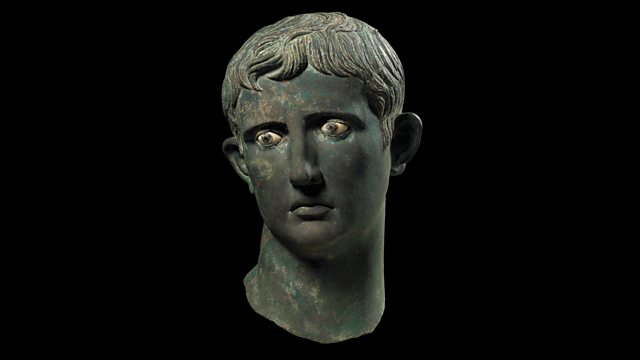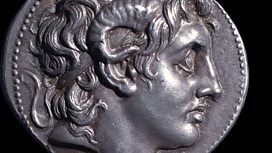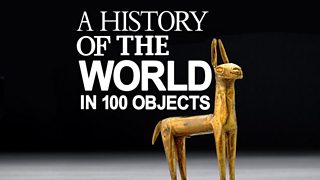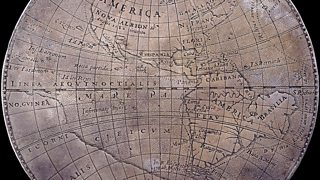Head of Augustus
The history of the world as charted through objects at the British Museum. Today the story of the great ruler Caesar Augustus - told through a 2000 year old bronze head
Neil MacGregor concludes the first week of the second part of his global history as told through objects from the British Museum. This week he has been exploring the lives and methods of powerful rulers around the world about 2000 years ago, from Alexander the Great in Egypt to Asoka in India. Today he introduces us to the great Roman emperor Augustus, whose powerful, God-like status is brilliantly enshrined in a larger than life bronze head with striking eyes.
Neil MacGregor describes how Augustus dramatically enlarged the Roman Empire, establishing his image as one of its most familiar objects. The historian Susan Walker and the politician Boris Johnson help explain the power and methodology of Augustus.
Producer: Anthony Denselow
Last on
More episodes
Next
You are at the last episode
![]()
More programmes from A History of the World in 100 Objects related to leaders & government
About this object
Location: Meroë, Sudan
Culture: Ancient Rome
Period: 27-25 BC
Material: Metal
��
This head of the emperor Augustus was originally part of a statue in Egypt. The Romans used statues to remind the empire's largely illiterate population of the power of the emperor. Augustus is always depicted as a youth to reflect his strength and vitality. This head was decapitated by an invading army from Meroë in modern-day Sudan. They buried the head under the temple steps as an insult to Augustus. Ironically, it was this act of defiance that preserved the head.
When did Rome become an empire?
Augustus was the first emperor of Rome. He transformed Rome from a republic, led by competing nobles, to an empire, ruled by one man. In 31 BC Augustus defeated the armies of Mark Anthony and Cleopatra and made Egypt a part of the empire. Egypt's immense wealth helped Augustus to develop an effective army to expand and protect the empire's borders. The Roman Empire enjoyed a period of long-lasting peace under Augustus' reign. When he died he was declared a god by the Roman Senate.
Did you know?
- After Augustus' death the month Sextilius was officially renamed August in his honour.
One face to rule them all
By Boris Johnson, Mayor of London
��
What’s striking about this bust is of course the hairstyle, because it is deliberately designed to echo the locks of Alexander the Great, the Hellenistic King, and what Augustus did - he was the first leader of Rome to claim that he was a God and in that he echoed Hellenistic ruler cult and by claiming that he was a God, he became a vital part of the glue that held the whole Roman Empire together. You could be out there in Spain or Gaul, you could be all over the world, you could go to a temple and you would find women with images of Augustus, of this man depicted in this bust sewn onto their cowls.
People at dinner parties in Rome, would have busts exactly like this above their mantle pieces - imagine how freaky that was - imagine if in today’s Britain we had busts of Gordon Brown above people’s mantle place in Islington, we would think it was a culture that was completely sick and mad, wouldn’t we? But that was how he was able to infuse the entire Roman Empire with that sense of loyalty and adherence to Rome.
If you wanted to become a local politician in the Roman Empire you became a member, you became a priest in the cult of Augustus.
Ultimate authority and power?
By Julie R. Anderson, curator, British Museum
��
The bronze head of Caesar Augustus, Emperor of Rome, has long occupied a prominent place in the affections of British Museum visitors, but what few realise is that this powerful and striking imperial sculpture was discovered in Sudan, not in a part of the Roman Empire.
While conducting excavations for the University of Liverpool in 1910, much to his surprise, John Garstang a British archaeologist, found this classical statue head buried beneath the threshold of a temple in the Kushite royal city of Meroe. In antiquity, those entering or leaving the temple would have purposefully trod on Augustus’ head in the process, an insulting act calculated to demonstrate as much contempt and derision towards him as possible.
Situated along the Nile near the sixth cataract, Meroe is roughly 200 km north of modern Khartoum, Sudan. What was this head, of the founder of the Roman Empire, doing so far from home?
Strabo, the classical historian, records that in 24 BC the ‘Aethiopians’, as the Kushites were known in the Greco-Roman world, attacked the southern border of the Roman province of Egypt with 30,000 men looting and pulling down imperial statues in Aswan, Elephantine and Philae including those of Augustus. The Kushites were led by a queen who was blind in one eye. Although later required to return their booty, it is clear that the Kushites did not return everything that they had taken as the presence of the statue head at Meroe clearly demonstrates.
This bronze head came from a larger than life statue of the Emperor and is perfectly proportioned in accordance with the classical Greek ideal of the human form. The inlaid eyes stare off into the distance and are comprised of glass, calcite and metal rings. Combined with the slightly turned neck, they serve to give the head a very life-like appearance.
Originally such statues of the ruler would have been spread throughout the provinces of the Roman Empire serving to remind his subjects of the Emperor’s ultimate authority and power.
Forever young
By Susan Walker, Keeper of Greek and Roman Antiquities, Ashmolean Museum
��
In classical Greece there was a very famous sculptor called Polykleitos who came from Argos, and Polykleitos developed a canon of proportions to represent the human figure. These were considered very beautiful, and very useful, and very helpful, and were very much studied at the time when Octavian was coming to power and turning into Augustus the first Roman Emperor.
So his rather small body - which was by no means perfect – became a Polykleitan hero, and his rather distracted expression and tousled hairstyle became settled, and purposeful, and combed into place, so he looked extremely reassuring. Having assumed this image when he was still in his 30s, he stayed with it until he died age 76 in AD 14. So there’s no suggestion in his portraits, even any subtle suggestion such as we see in the portraits of our Queen Elizabeth II, for example, of any aging process at all.
And this was a very enduring image – we have surviving even today over 250 images of Augustus which come from all over the Roman Empire in every size and every medium, and they are pretty much the same; the variations are really not very significant. So the portrait was very, very recognisable, and very enduring, and it was very successful marketing, in a sense, of an image because Augustus has never had a bad press.
Transcript
Broadcasts
- Fri 21 May 2010 09:45�鶹������ҳ��� Radio 4 FM
- Fri 21 May 2010 19:45�鶹������ҳ��� Radio 4
- Sat 22 May 2010 00:30�鶹������ҳ��� Radio 4
- Fri 4 Dec 2020 13:45�鶹������ҳ��� Radio 4
Featured in...
![]()
War—A History of the World in 100 Objects
A History of the World in 100 Objects - objects related to war.
![]()
Leaders and Government—A History of the World in 100 Objects
More programmes from A History of the World in 100 Objects related to leaders & government
Podcast
-
![]()
A History of the World in 100 Objects
Director of the British Museum, Neil MacGregor, retells humanity's history through objects





